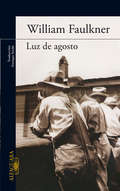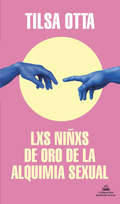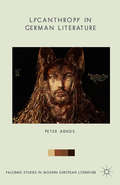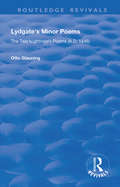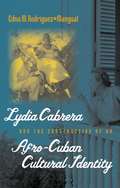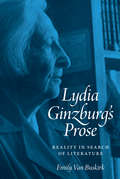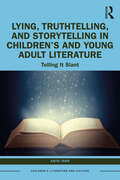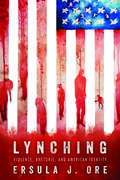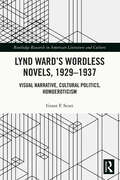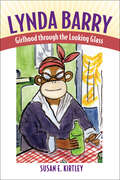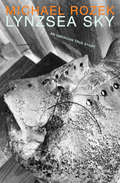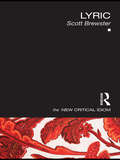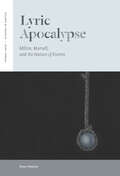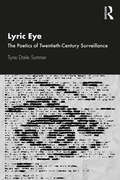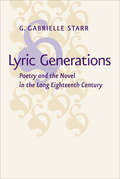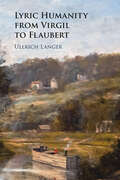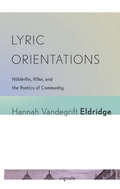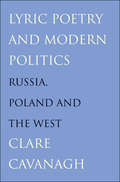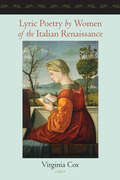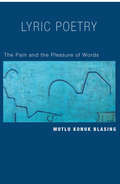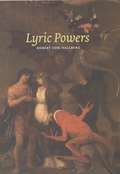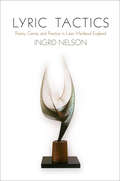- Table View
- List View
Luz de agosto (Alfaguara Literatura Ser.)
by William FaulknerLuz de agosto es una de las obras más representativas del premio Nobel de Literatura William Faulkner. En Luz de agosto aparecen retratados algunos de los personajes más memorables de Faulkner: la cándida e intrépida Lena Grove en busca del padre de su hijo; el reverendo Gal Hightower, atormentado por constante visiones de soldados de caballería confederados, y Joe Christmas, un misterioso vagabundo consumido por los orígenes raciales de sus antepasados. Faulkner, además de haber sido el innovador de una forma de narrar que ha influido poderosamente en las generaciones que le han continuado, fue el cronista de los más notables hechos, costumbres y personajes de su tierra. Luz de agosto es una de las obras más representativas de un hombre que, trabajando sobre la historia y haciendo campear la imaginación, logró convertirse en uno de los escritores más importantes de su siglo.
Lxs niñxs de oro de la alquimia sexual
by Tilsa Otta«Todos los orgasmos que he tenido esta semana me han permitido acceder a Dios». Los orgasmos que Cristy alcanza con su pareja son de índole divina: gracias a ellos no solo contempla a Dios, sino que se le revelan episodios del futuro. La conciencia de este «don» la obliga a formularse ciertas interrogantes: ¿cómo debe proceder?, ¿por qué ha sido elegida?, ¿cuál es la finalidad? Para responderlas, Cristy decide armar un archivo que dé cuenta de sus experiencias e investigaciones. Su vida se transforma así en un campo de trabajo experimental donde confluyen el esoterismo, la poesía, el libertinaje sexual, las drogas afrodisíacas, el feminismo, los misterios de Eleusis, el yoga, las orgías místicas y la adivinación orgásmica. Un cóctel supranatural y sicalíptico que sacude los cimientos existenciales de la protagonista. Mediante un estilo conversacional, lúdico y veloz, esta novela de Tilsa Otta apuesta por una historia en la que se impone una voz de inusitada frescura e irreverencia.
Lycanthropy in German Literature (Palgrave Studies in Modern European Literature)
by Peter ArndsLycanthropy in German Literature argues that as a symbol of both power and parasitism, the human wolf of the Germanic Middle Ages is iconic to the representation of the persecution of undesirables in the German cultural imagination from the early modern age to the post-war literary scene.
Lycurgan Athens and the Making of Classical Tragedy
by Johanna HaninkThrough a series of interdisciplinary studies this book argues that the Athenians themselves invented the notion of 'classical' tragedy just a few generations after the city's defeat in the Peloponnesian War. In the third quarter of the fourth century BC, and specifically during the 'Lycurgan Era' (338-322 BC), a number of measures were taken in Athens to affirm to the Greek world that the achievement of tragedy was owed to the unique character of the city. By means of rhetoric, architecture, inscriptions, statues, archives and even legislation, the 'classical' tragedians (Aeschylus, Sophocles and Euripides) and their plays came to be presented as both the products and vital embodiments of an idealised Athenian past. This study marks the first account of Athens' invention of its own theatrical heritage and sheds new light upon the interaction between the city's literary and political history.
Lydgate's Minor Poems: The Two Nightingale Poems (A.D. 1446) (Routledge Revivals #No. 80)
by Otto GlauningFirst published in 1900, this volume includes the two versions of Lydgate’s Middle-English Nightingale poems along with glosses. A detailed scholarly introduction is provided by Otto Glauning, PhD, including analysis of the manuscripts, metre, linguistic significance and the manuscripts’ sources.
Lydia Cabrera and the Construction of an Afro-Cuban Cultural Identity
by Edna M. Rodríguez-PlateLydia Cabrera (1900-1991), an upper-class white Cuban intellectual, spent many years traveling through Cuba collecting oral histories, stories, and music from Cubans of African descent. Her work is commonly viewed as an extension of the work of her famous brother-in-law, Cuban anthropologist Fernando Ortiz, who initiated the study of Afro-Cubans and the concept of transculturation. Here, Edna Rodriguez-Mangual challenges this perspective, proposing that Cabrera's work offers an alternative to the hegemonizing national myth of Cuba articulated by Ortiz and others.Rodriguez-Mangual examines Cabrera's ethnographic essays and short stories in context. By blurring fact and fiction, anthropology and literature, Cabrera defied the scientific discourse used by other anthropologists. She wrote of Afro-Cubans not as objects but as subjects, and in her writings, whiteness, instead of blackness, is gazed upon as the "other." As Rodriguez-Mangual demonstrates, Cabrera rewrote the history of Cuba and its culture through imaginative means, calling into question the empirical basis of anthropology and placing Afro-Cuban contributions at the center of the literature that describes the Cuban nation and its national identity.
Lydia Ginzburg's Prose
by Emily Van BuskirkThe Russian writer Lydia Ginzburg (1902-90) is best known for her Notes from the Leningrad Blockade and for influential critical studies, such as On Psychological Prose, investigating the problem of literary character in French and Russian novels and memoirs. Yet she viewed her most vital work to be the extensive prose fragments, composed for the desk drawer, in which she analyzed herself and other members of the Russian intelligentsia through seven traumatic decades of Soviet history. In this book, the first full-length English-language study of the writer, Emily Van Buskirk presents Ginzburg as a figure of previously unrecognized innovation and importance in the literary landscape of the twentieth century.Based on a decade's work in Ginzburg's archives, the book discusses previously unknown manuscripts and uncovers a wealth of new information about the author's life, focusing on Ginzburg's quest for a new kind of writing adequate to her times. She writes of universal experiences--frustrated love, professional failures, remorse, aging--and explores the modern fragmentation of identity in the context of war, terror, and an oppressive state. Searching for a new concept of the self, and deeming the psychological novel (a beloved academic specialty) inadequate to express this concept, Ginzburg turned to fragmentary narratives that blur the lines between history, autobiography, and fiction.This full account of Ginzburg's writing career in many genres and emotional registers enables us not only to rethink the experience of Soviet intellectuals, but to arrive at a new understanding of writing and witnessing during a horrific century.
Lying, Truthtelling, and Storytelling in Children’s and Young Adult Literature: Telling It Slant (Children's Literature and Culture)
by Anita TarrEven though we instruct our children not to lie, the truth is that lying is a fundamental part of children’s development—socially, cognitively, emotionally, morally. Lying can sometimes be more compassionate than telling the truth, even more ethical. Reading specific children’s books can instruct child readers how to be guided by an etiquette of lying, to know when to tell the truth and when to lie. Equally important, these stories can help prevent them from being prey to those liars who are intent on taking advantage of them. Becoming a critical reader requires that one learn how to lie judiciously as well as to see through others’ lies. When humans first began to speak, we began to lie. When we began to lie, we started telling stories. This is the paradox, that in order to tell truthful stories, we must be good liars. Novels about child-artists showcased here illustrate how the protagonist embraces this paradox, accepting the stigma that a writer is a liar who tells the truth. Emily Dickinson’s phrase “telling it slant” best expresses the vision of how writers for children and young adults negotiate the conundrum of both protecting child readers and teaching them to protect themselves. This volume explores the pervasiveness of lying as well as the necessity for lying in our society; the origins of lying as connected to language acquisition; the realization that storytelling is both lying and truthtelling; and the negotiations child-artists must process in order to grasp the paradox that to become storytellers they must become expert liars and lie-detectors.
Lynching: Violence, Rhetoric, and American Identity (Race, Rhetoric, and Media Series)
by Ersula J. OreWinner of the 2020 Rhetoric Society of America Book AwardWhile victims of antebellum lynchings were typically white men, postbellum lynchings became more frequent and more intense, with the victims more often black. After Reconstruction, lynchings exhibited and embodied links between violent collective action, American civic identity, and the making of the nation.Ersula J. Ore investigates lynching as a racialized practice of civic engagement, in effect an argument against black inclusion within the changing nation. Ore scrutinizes the civic roots of lynching, the relationship between lynching and white constitutionalism, and contemporary manifestations of lynching discourse and logic today. From the 1880s onward, lynchings, she finds, manifested a violent form of symbolic action that called a national public into existence, denoted citizenship, and upheld political community.Grounded in Ida B. Wells’s summation of lynching as a social contract among whites to maintain a racial order, at its core, Ore’s book speaks to racialized violence as a mode of civic engagement. Since violence enacts an argument about citizenship, Ore construes lynching and its expressions as part and parcel of America’s rhetorical tradition and political legacy.Drawing upon newspapers, official records, and memoirs, as well as critical race theory, Ore outlines the connections between what was said and written, the material practices of lynching in the past, and the forms these rhetorics and practices assume now. In doing so, she demonstrates how lynching functioned as a strategy interwoven with the formation of America’s national identity and with the nation’s need to continually restrict and redefine that identity. In addition, Ore ties black resistance to lynching, the acclaimed exhibit Without Sanctuary, recent police brutality, effigies of Barack Obama, and the killing of Trayvon Martin.
Lynd Ward’s Wordless Novels, 1929-1937: Visual Narrative, Cultural Politics, Homoeroticism (Routledge Research in American Literature and Culture)
by Grant F. ScottThis book offers the first multidisciplinary analysis of the "wordless novels" of American woodcut artist and illustrator Lynd Ward (1905-1985), who has been enormously influential in the development of the contemporary graphic novel. The study examines his six pictorial novels, each part of an evolving experiment in a new form of visual narrative that offers a keen intervention in the cultural and sexual politics of the 1930s. The novels form a discrete group – much like Beethoven’s piano sonatas or Keats’s great odes – in which Ward evolves a unique modernist style (cinematic, expressionist, futurist, realist, documentary) and grapples with significant cultural and political ideas in a moment when the American experiment and capitalism itself hung in the balance. In testing the limits of a new narrative form, Ward’s novels require a versatile critical framework as sensitive to German Expressionism and Weimar cinema as to labor politics and the new energies of proletarian homosexuality.
Lynda Barry: Girlhood through the Looking Glass (Great Comics Artists Series)
by Susan E. KirtleyBest known for her long-running comic strip Ernie Pook's Comeek, illustrated fiction (Cruddy, The Good Times Are Killing Me), and graphic novels (One! Hundred! Demons!), the art of Lynda Barry (b. 1956) has branched out to incorporate plays, paintings, radio commentary, and lectures. With a combination of simple, raw drawings and mature, eloquent text, Barry's oeuvre blurs the boundaries between fiction and memoir, comics and literary fiction, and fantasy and reality. Her recent volumes What It Is (2008) and Picture This (2010) fuse autobiography, teaching guide, sketchbook, and cartooning into coherent visions. In Lynda Barry: Girlhood through the Looking Glass, author Susan E. Kirtley examines the artist's career and contributions to the field of comic art and beyond. The study specifically concentrates on Barry's recurring focus on figures of young girls, in a variety of mediums and genres. Barry follows the image of the girl through several lenses—from text-based novels to the hybrid blending of text and image in comic art, to art shows and coloring books. In tracing Barry's aesthetic and intellectual development, Kirtley reveals Barry's work to be groundbreaking in its understanding of femininity and feminism.
Lynzsea Sky: An American True Story
by Michael RozekLynzsea Sky, a twenty-something college student, tells the author her heartbreaking, disturbing, and culture-challenging life story. She speaks at first hesitantly, then with increasing clarity about sex, drugs, family life, education, tattoos, homelessness, her dreams of becoming a filmmaker, her brother's time in prison, and her mother's struggle with mental illness.<P><P>The book is just the conversation; the absence of anything else makes this a groundbreaking new form of nonfiction. The lean prose is void of stylistic hijinks, drawing the reader in without drawing attention to the writer.The author's first book is part of a planned series called American True Stories, all of which will be similarly dialogue based. Michael Rozek's work illuminates real American lives and gives a voice to people who often are overlooked by the mainstream media.Michael Rozek has written more than two thousand articles for various national magazines including Rolling Stone, Esquire, Sports Illustrated, and The Village Voice in a career spanning nearly forty years. He walked away from a lucrative free-lance career to publish the popular Rozek's Newsletter in the 1990s in response to the "fast food" journalism he saw increasingly creeping into American magazines. For more than a decade, Rozek and his wife Charlotte have struggled with homelessness and poverty, yet Rozek continues to talk to and write about everyday Americans with empathy and insight. This is his first book.
Lyric (The New Critical Idiom)
by Scott BrewsterThe term ‘lyric’ has evolved, been revised, redefined and contested over the centuries. In this fascinating introduction, Scott Brewster: traces the history of the term from its classical origins through the early modern, Romantic and Victorian periods and up to the twenty-first century demonstrates the influence of lyric on poetic practice, literature, music and other popular cultural forms uses three aspects -- the lyric ‘self’, love and desire and the relationship between lyric, poetry and performance -- as focal points for further discussion not only charts the history of lyric theory and practice but re-examines assumptions about the lyric form in the context of recent theoretical accounts of poetic discourse. Offering clarity and structure to this often intense and emotive field, Lyric offers essential insights for students of literature, performance, music and cultural studies.
Lyric Apocalypse: Milton, Marvell, and the Nature of Events (Verbal Arts: Studies in Poetics)
by Ryan NetzleyWhat’s new about the apocalypse? Revelation does not allow us to look back after the end and enumerate pivotal turning points. It happens in an immediate encounter with the transformatively new.John Milton’s and Andrew Marvell’s lyrics attempt to render the experience of such an apocalyptic change in the present. In this respect they take seriously the Reformation’s insistence that eschatology is a historical phenomenon. Yet these poets are also reacting to the Regicide, and, as a result, their works explore very modern questions about the nature of events, what it means for a significant historical occasion to happen.Lyric Apocalypse argues that Milton’s and Marvell’s lyrics challenge any retrospective understanding of events, including one built on a theory of revolution. Instead, these poems show that there is no “after” to the apocalypse, that if we are going to talk about change, we should do so in the present, when there is still time to do something about it. For both of these poets, lyric becomes a way to imagine an apocalyptic event that would be both hopeful and new.
Lyric Eye: The Poetics of Twentieth-Century Surveillance
by Tyne Daile SumnerLyric Eye: The Poetics of Twentieth-Century Surveillance presents the first detailed study of the relationship between poetry and surveillance. It critically examines the close connection between American lyric poetry and a burgeoning U.S. state surveillance apparatus from 1920 to the 1960s. The book explores the myriad ways that poets—Ezra Pound, William Carlos Williams, W.H. Auden, Langston Hughes, James Baldwin, Sylvia Plath, Gertrude Stein, Robert Lowell, Allen Ginsberg and others—explored a developing and fraught environment in which the growing power of American investigative agencies, such as the FBI under J. Edgar Hoover, imposed new pressures on cultural discourse and personal identity. In analysing twentieth-century American poetry and its various ideas about "the self," Lyric Eye demonstrates the extent to which poetry and surveillance employ similar styles of information gathering such as observation, overhearing, imitation, abstraction, repurposing of language, subversion, fragmentation and symbolism. Ground-breaking and prescient, this book will be of great interest to scholars and researchers of literature, politics, surveillance and intelligence studies, and digital humanities.
Lyric Generations: Poetry and the Novel in the Long Eighteenth Century
by G. Gabrielle StarrEighteenth-century British literary history was long characterized by two central and seemingly discrete movements—the emergence of the novel and the development of Romantic lyric poetry. In fact, recent scholarship reveals that these genres are inextricably bound: constructions of interiority developed in novels changed ideas about what literature could mean and do, encouraging the new focus on private experience and self-perception developed in lyric poetry.In Lyric Generations, Gabrielle Starr rejects the genealogy of lyric poetry in which Romantic poets are thought to have built solely and directly upon the works of Chaucer, Spenser, Shakespeare, and Milton. She argues instead that novelists such as Richardson, Haywood, Behn, and others, while drawing upon earlier lyric conventions, ushered in a new language of self-expression and community which profoundly affected the aesthetic goals of lyric poets. Examining the works of Cowper, Smith, Wordsworth, Coleridge, and Keats in light of their competitive dialogue with the novel, Starr advances a literary history that considers formal characteristics as products of historical change. In a world increasingly defined by prose, poets adapted the new forms, characters, and moral themes of the novel in order to reinvigorate poetic practice.
Lyric Humanity from Virgil to Flaubert: Love, Pleasure, Happiness And Death
by Ullrich LangerFrom the Georgics of Virgil to Flaubert's landscapes of happiness, Ullrich Langer argues that lyric representation holds a particular power to address our humanity. Ranging across a vast chronology, the book investigates how such poetry and prose activates our capacities for empathy, equity, irony and reasoning, while educating us in pleasure and helping us comprehend death. Each chapter constitutes a fresh encounter with some of the most celebrated texts of European literary history, demonstrating how the lyrical works, and what it elicits in us. Through deft rhetorical and philological analysis, the study presents the value of literary studies for both ethical purposes and aesthetic ends.
Lyric Orientations: Hölderlin, Rilke, and the Poetics of Community
by Hannah Vandegrifte EldridgeIn Lyric Orientations, Hannah Vandegrift Eldridge explores the power of lyric poetry to stir the social and emotional lives of human beings in the face of the ineffable nature of our mortality. She focuses on two German-speaking masters of lyric prose and poetry: Friedrich Hölderlin (1770-1843) and Rainer Maria Rilke (1875-1926). While Hölderlin and Rilke are stylistically very different, each believes in the power of poetic language to orient us as social beings in contexts that otherwise can be alienating. They likewise share the conviction that such alienation cannot be overcome once and for all in any universal event. Both argue that to deny the uncertainty created by the absence of any such event (or to deny the alienation itself) is likewise to deny the particularly human condition of uncertainty and mortality. By drawing on the work of Stanley Cavell, who explores how language in all its formal aspects actually enables us to engage meaningfully with the world, Eldridge challenges poststructuralist scholarship, which stresses the limitations--even the failure--of language in the face of reality. Eldridge provides detailed readings of Hölderlin and Rilke and positions them in a broader narrative of modernity that helps make sense of their difficult and occasionally contradictory self-characterizations. Her account of the orienting and engaging capabilities of language reconciles the extraordinarily ambitious claims that Hölderlin and Rilke make for poetry--that it can create political communities, that it can change how humans relate to death, and that it can unite the sensual and intellectual components of human subjectivity--and the often difficult, fragmented, or hermetic nature of their individual poems.
Lyric Poetry and Modern Politics
by Clare CavanaghLyric Poetry and Modern Politics explores the intersection of poetry, national life, and national identity in Poland and Russia, from 1917 to the present. As a corrective to recent trends in criticism, acclaimed translator and critic Clare Cavanagh demonstrates how the practice of the personal lyric in totalitarian states such as Russia and Poland did not represent an escapist tendency; rather it reverberated as a bold political statement and at times a dangerous act. Cavanagh also provides a comparative study of modern poetry from the perspective of the eastern and western sides of the Iron Curtain. Among the poets discussed are Blok, Mayakovsky, Akhmatova, Yeats, Whitman, Frost, Szymborska, Zagajewski, and Milosz; close readings of individual poems are included, some translated for the first time. Cavanagh examines these poets and their work as a challenge to Western postmodernist theories, thus offering new perspectives on twentieth-century lyric poetry.
Lyric Poetry by Women of the Italian Renaissance
by Virginia CoxBilingual, annotated edition of more than 200 poems by Italian Renaissance women, many of which have never before been published in English.Outstanding Academic Title, ChoiceLyric Poetry by Women of the Italian Renaissance is the first modern anthology of verse by Italian women of this period to give a full representation of the richness and diversity of their output. Although familiar authors such as Vittoria Colonna, Gaspara Stampa, and Veronica Gambara are well represented, half of the fifty-four poets featured are unknown even to many specialists. Especially noteworthy is an extensive selection of verse from the period following 1560, which has received little or no critical attention. This later, strikingly experimental, proto-Baroque tradition of verse is reconstructed here for the first time.Virginia Cox creates both a scholarly teaching resource and a collection of poetry accessible to general readers with no previous knowledge of the Italian poetic tradition. Each poem is presented in its original language, accompanied by a translation and commentary. An introduction traces the history of Italian lyric poetry from the fifteenth to the seventeenth century. Cox also provides a guide to meter, rhythm, and rhyme, as well as a glossary of rhetorical terms and a biographical dictionary of authors.Organized thematically, this book offers poems about love, religion, and politics; verse addressed to patrons, friends, family, and places; and polemical and correspondence verse. Four languages are represented: Greek, Latin, literary Tuscan of various levels of standardization, and the stylized rustic dialect of pavan. The volume contains more than 200 poems, of which about a quarter have never before been published in a modern edition and more than a third have not previously been available in English translation."Exhaustive and insightful... This is an amazing book, a major achievement in the field of women's studies."—Renaissance Quarterly, reviewing Women’s Writing in Italy, 1400–1650
Lyric Poetry: The Pain and the Pleasure of Words
by Mutlu BlasingLyric poetry has long been regarded as the intensely private, emotional expression of individuals, powerful precisely because it draws readers into personal worlds. But who, exactly, is the "I" in a lyric poem, and how is it created? In Lyric Poetry, Mutlu Blasing argues that the individual in a lyric is only a virtual entity and that lyric poetry takes its power from the public, emotional power of language itself. In the first major new theory of the lyric to be put forward in decades, Blasing proposes that lyric poetry is a public discourse deeply rooted in the mother tongue. She looks to poetic, linguistic, and psychoanalytic theory to help unravel the intricate historical processes that generate speaking subjects, and concludes that lyric forms convey both personal and communal emotional histories in language. Focusing on the work of such diverse twentieth-century American poets as T. S. Eliot, Ezra Pound, Wallace Stevens, and Anne Sexton, Blasing demonstrates the ways that the lyric "I" speaks, from first to last, as a creation of poetic language.
Lyric Powers
by Robert Von HallbergThe authority of poetry varies from one period to another, from one culture to another. For Robert von Hallberg, the authority of lyric poetry has three sources: religious affirmation, the social institutions of those who speak the idioms from which particular poems are made, and the extraordinary cognition generated by the formal and musical resources of poems. Lyric Powers helps students, poets, and general readers to recognize the pleasures and understand the ambitions of lyric poetry. To explain why a reader might prefer one kind of poem to another, von Hallberg analyzes--beyond the political and intellectual significance of poems--the musicality of both lyric poetry and popular song, including that of Tin Pan Alley and doo-wop. He shows that poets have distinctive intellectual resources--not just rhetorical resources--for examining their subjects, and that the power of poetic language to generalize, not particularize, is what justly deserves a critic's attention. The first book in more than a decade from this respected critic, Lyric Powers will be celebrated as a genuine event by readers of poetry and literary criticism.
Lyric Powers
by Robert von HallbergThe authority of poetry varies from one period to another, from one culture to another. For Robert von Hallberg, the authority of lyric poetry has three sources: religious affirmation, the social institutions of those who speak the idioms from which particular poems are made, and the extraordinary cognition generated by the formal and musical resources of poems. Lyric Powers helps students, poets, and general readers to recognize the pleasures and understand the ambitions of lyric poetry. To explain why a reader might prefer one kind of poem to another, von Hallberg analyzes—beyond the political and intellectual significance of poems—the musicality of both lyric poetry and popular song, including that of Tin Pan Alley and doo-wop. He shows that poets have distinctive intellectual resources—not just rhetorical resources—for examining their subjects, and that the power of poetic language to generalize, not particularize, is what justly deserves a critic’s attention. The first book in more than a decade from this respected critic, Lyric Powers will be celebrated as a genuine event by readers of poetry and literary criticism.
Lyric Shame: The "Lyric" Subject of Contemporary American Poetry
by Gillian WhiteGillian White argues that the poetry wars among critics and practitioners are shaped by "lyric shame"--an unspoken but pervasive embarrassment over what poetry is, should be, and fails to be. "Lyric" is less a specific genre than a way to project subjectivity onto poems--an idealized poem that is nowhere and yet everywhere.
Lyric Tactics: Poetry, Genre, and Practice in Later Medieval England (The Middle Ages Series)
by Ingrid NelsonWhat shall we make of medieval English lyrics? They have no fixed line or meter, no consistent point of view, and their content may seem misaligned with the other texts in manuscripts in which they are found. Yet in Lyric Tactics, Ingrid Nelson argues that the lyric poetry of later medieval England is a distinct genre defined not by its poetic features—rhyme, meter, and stanza forms—but by its modes of writing and performance, which are ad hoc, improvisatory, and situational. Nelson looks at anonymous devotional and love poems that circulated in manuscripts of practical, religious, and literary material or were embedded in popular, courtly, and liturgical works. For her, the poems' abilities to participate in multiple modes of transmission are "lyric tactics," responsive and contingent modes of practice that emerge in opposition to institutional or poetic norms.Working across the three languages of medieval England (English, French, and Latin), Nelson examines the tactics of poetic voice in the trilingual texts of British Library MS Harley 2253, which contains the well-known English "Harley lyrics." In a study of the English hymns and French lyrics of the commonplace book of William Herebert, she unearths the moral implications of lyric tactics for the friars who produced and disseminated them. And last, she examines the work of Geoffrey Chaucer and shows how his introduction of Continental poetic forms such as the balade and the rondeau suggests continuity with rather than a break from earlier English lyric. Combining literary analysis, manuscript studies, and cultural history with modern social theory, Ingrid Nelson demonstrates that medieval lyric poetry formed a crucial part of the fabric of later medieval English society.
